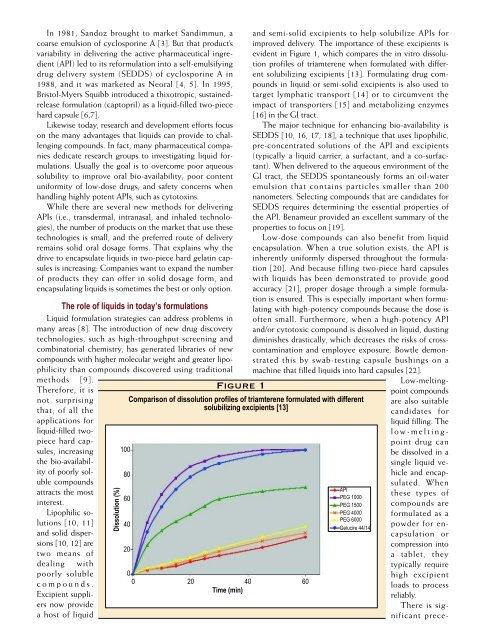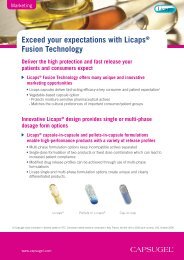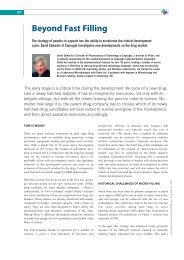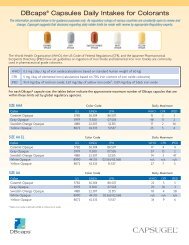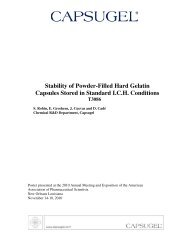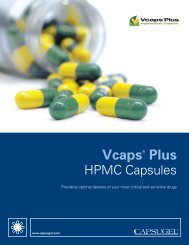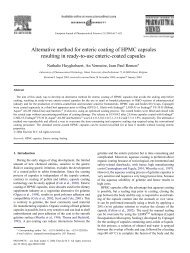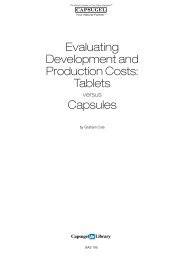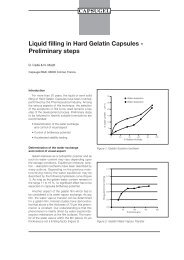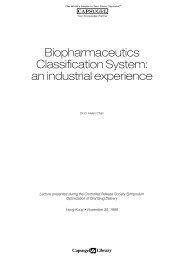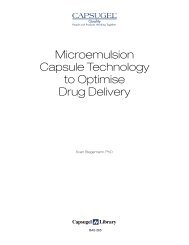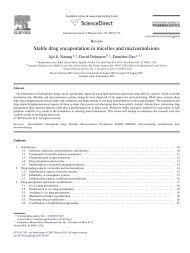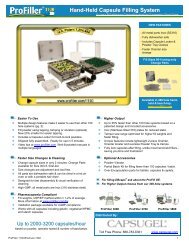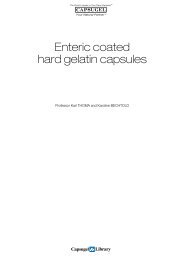Filling two-piece hard gelatin capsules with liquids - Capsugel
Filling two-piece hard gelatin capsules with liquids - Capsugel
Filling two-piece hard gelatin capsules with liquids - Capsugel
Create successful ePaper yourself
Turn your PDF publications into a flip-book with our unique Google optimized e-Paper software.
In 1981, Sandoz brought to market Sandimmun, a<br />
coarse emulsion of cyclosporine A [3]. But that product’s<br />
variability in delivering the active pharmaceutical ingredient<br />
(API) led to its reformulation into a self-emulsifying<br />
drug delivery system (SEDDS) of cyclosporine A in<br />
1988, and it was marketed as Neoral [4, 5]. In 1995,<br />
Bristol-Myers Squibb introduced a thixotropic, sustainedrelease<br />
formulation (captopril) as a liquid-filled <strong>two</strong>-<strong>piece</strong><br />
<strong>hard</strong> capsule [6,7].<br />
Likewise today, research and development efforts focus<br />
on the many advantages that <strong>liquids</strong> can provide to challenging<br />
compounds. In fact, many pharmaceutical companies<br />
dedicate research groups to investigating liquid formulations.<br />
Usually the goal is to overcome poor aqueous<br />
solubility to improve oral bio-availability; poor content<br />
uniformity of low-dose drugs; and safety concerns when<br />
handling highly potent APIs, such as cytotoxins.<br />
While there are several new methods for delivering<br />
APIs (i.e., transdermal, intranasal, and inhaled technologies),<br />
the number of products on the market that use these<br />
technologies is small, and the preferred route of delivery<br />
remains solid oral dosage forms. That explains why the<br />
drive to encapsulate <strong>liquids</strong> in <strong>two</strong>-<strong>piece</strong> <strong>hard</strong> <strong>gelatin</strong> <strong>capsules</strong><br />
is increasing: Companies want to expand the number<br />
of products they can offer in solid dosage form, and<br />
encapsulating <strong>liquids</strong> is sometimes the best or only option.<br />
The role of <strong>liquids</strong> in today’s formulations<br />
Liquid formulation strategies can address problems in<br />
many areas [8]. The introduction of new drug discovery<br />
technologies, such as high-throughput screening and<br />
combinatorial chemistry, has generated libraries of new<br />
compounds <strong>with</strong> higher molecular weight and greater lipophilicity<br />
than compounds discovered using traditional<br />
methods [9].<br />
Therefore, it is<br />
not surprising<br />
that, of all the<br />
applications for<br />
liquid-filled <strong>two</strong><strong>piece</strong><br />
<strong>hard</strong> <strong>capsules</strong>,<br />
increasing<br />
the bio-availability<br />
of poorly soluble<br />
compounds<br />
attracts the most<br />
interest.<br />
Lipophilic solutions<br />
[10, 11]<br />
and solid dispersions<br />
[10, 12] are<br />
<strong>two</strong> means of<br />
dealing <strong>with</strong><br />
poorly soluble<br />
compounds.<br />
Excipient suppliers<br />
now provide<br />
a host of liquid<br />
Dissolution (%)<br />
100<br />
80<br />
60<br />
40<br />
20<br />
Figure 1<br />
and semi-solid excipients to help solubilize APIs for<br />
improved delivery. The importance of these excipients is<br />
evident in Figure 1, which compares the in vitro dissolution<br />
profiles of triamterene when formulated <strong>with</strong> different<br />
solubilizing excipients [13]. Formulating drug compounds<br />
in liquid or semi-solid excipients is also used to<br />
target lymphatic transport [14] or to circumvent the<br />
impact of transporters [15] and metabolizing enzymes<br />
[16] in the GI tract.<br />
The major technique for enhancing bio-availability is<br />
SEDDS [10, 16, 17, 18], a technique that uses lipophilic,<br />
pre-concentrated solutions of the API and excipients<br />
(typically a liquid carrier, a surfactant, and a co-surfactant).<br />
When delivered to the aqueous environment of the<br />
GI tract, the SEDDS spontaneously forms an oil-water<br />
emulsion that contains particles smaller than 200<br />
nanometers. Selecting compounds that are candidates for<br />
SEDDS requires determining the essential properties of<br />
the API. Benameur provided an excellent summary of the<br />
properties to focus on [19].<br />
Low-dose compounds can also benefit from liquid<br />
encapsulation. When a true solution exists, the API is<br />
inherently uniformly dispersed throughout the formulation<br />
[20]. And because filling <strong>two</strong>-<strong>piece</strong> <strong>hard</strong> <strong>capsules</strong><br />
<strong>with</strong> <strong>liquids</strong> has been demonstrated to provide good<br />
accuracy [21], proper dosage through a simple formulation<br />
is ensured. This is especially important when formulating<br />
<strong>with</strong> high-potency compounds because the dose is<br />
often small. Furthermore, when a high-potency API<br />
and/or cytotoxic compound is dissolved in liquid, dusting<br />
diminishes drastically, which decreases the risks of crosscontamination<br />
and employee exposure. Bowtle demonstrated<br />
this by swab-testing capsule bushings on a<br />
machine that filled <strong>liquids</strong> into <strong>hard</strong> <strong>capsules</strong> [22].<br />
Comparison of dissolution profiles of triamterene formulated <strong>with</strong> different<br />
solubilizing excipients [13]<br />
0<br />
0 20 40 60<br />
Time (min)<br />
API<br />
PEG 1000<br />
PEG 1500<br />
PEG 4000<br />
PEG 6000<br />
Gelucire 44/14<br />
Low-meltingpoint<br />
compounds<br />
are also suitable<br />
candidates for<br />
liquid filling. The<br />
low-meltingpoint<br />
drug can<br />
be dissolved in a<br />
single liquid vehicle<br />
and encapsulated.<br />
When<br />
these types of<br />
compounds are<br />
formulated as a<br />
powder for encapsulation<br />
or<br />
compression into<br />
a tablet, they<br />
typically require<br />
high excipient<br />
loads to process<br />
reliably.<br />
There is significant<br />
prece-


